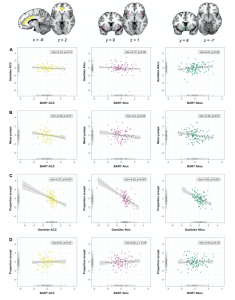Taking risks is an adaptive aspect of human life that can promote happiness and success. However, engagement in maladaptive risk taking can have detrimental effects on individual as well as societal levels of health, wealth and criminality. One approach to understanding and, ultimately, predicting individual differences in risk taking has been to illuminate the biological substrates, specifically the neural pathways. In the past, brain activation has been associated with or even found to be predictive of risky behaviors, yet one fundamental problem of existing studies relates to the challenge of measuring risk taking: convergence between risk-taking measures is low, both at the level of behavior and brain activation. By extension, whether brain activation is merely correlated with or actually predictive of real-life risky behaviors is also likely to vary as a function of the measure used.
In our new paper, out in Frontiers in Behavioral Neuroscience, we addressed this issue by analyzing within-participant neuroimaging data for two widely used risk-taking tasks collected from the imaging subsample of the Basel–Berlin Risk Study (N = 116 young human adults). We focused on core brain regions implicated in risk taking, and examined average (that is, group-level) activation for risky versus safe choices in the Balloon Analogue Risk Task and a Monetary Gambles task. Importantly, we also examined associations between individuals’ brain activation in risk-related brain areas and various risk-related outcomes, including psychometrically derived risk preference factors. We found that, on average, risky decisions in both tasks were associated with increased activation in the nucleus accumbens, a small subcortical brain structure with a central role in the brain’s reward circuitry. However, the results from our individual differences analyses support the idea that the presence and directionality of associations between brain activation and risk taking varies as a function of the risk-taking measures used to capture individual differences.
Read the full paper here for a thorough discussion of the findings, including implications for intervention and prevention efforts, and our recommendations for future research aimed at predicting real-life behavior from brain markers.
Citation: Tisdall, L., Frey, R., Horn, A., Ostwald, D., Horvath, L., Pedroni, A., Rieskamp, J., Blankenburg, F., Hertwig, R. and Mata, R., 2020. Brain–Behavior Associations for Risk Taking Depend on the Measures Used to Capture Individual Differences. Frontiers in Behavioral Neuroscience, 14, p.194.

Be the first to leave a comment. Don’t be shy.